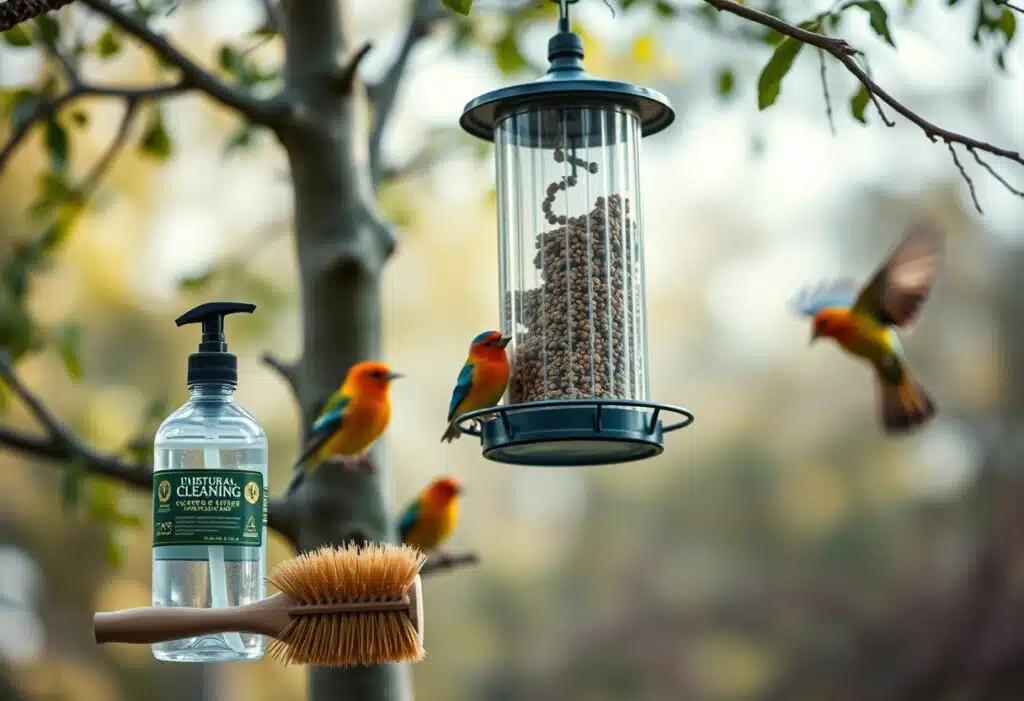What is the best solution for cleaning bird feeders?
Bird feeders are a delightful way to connect with your feathered friends, but keeping them clean is necessary to prevent diseases. The best solutions for cleaning your feeders include a mix of one part bleach to nine parts water or a simple soapy water solution. Regularly What is the best safe chemical to use to clean wild bird … your feeders not only ensures a healthy environment for visiting wild birds but also helps you enjoy the beauty of birdwatching without worries about sick birds.
Key Takeaways:
- Use Safe Solutions: For cleaning your bird feeders, the Audubon Society recommends using a nine parts water to one part bleach solution or a three parts water to one part vinegar solution. These will help eliminate bacteria and keep your feeders safe for wild birds.
- Regular Cleaning Schedule: It’s important to clean your bird feeders at least once or twice a month, and more often if you notice moldy seed or if the weather is hot or humid.
- Soak and Scrub: Before scrubbing, you can soak your feeders in hot, soapy water for about 15 minutes. This makes it easier to remove debris and greasy residue from high-fat bird seed mixes. After soaking, thoroughly rinse each part with hot water before letting it dry completely.

Why Clean Bird Feeders?
The importance of cleaning your bird feeders cannot be overstated. Dirty feeders can harbor harmful bacteria and mold, which may lead to serious health risks for your feathered friends. Regular cleaning helps ensure that your backyard birds, such as finches and hummingbirds, stay healthy and free from illness while enjoying their meals.
Health Risks to Birds
Clean feeders are vital for preventing the spread of bird diseases like salmonellosis, which can afflict numerous wild birds. Moldy feed and contaminated feeders often harbor bacteria and parasites that can make birds sick or even lead to fatalities. When birds feed on spoiled seeds or from dirty feeders, they are more susceptible to illnesses that can impact their migration and overall health.
Attracting Pests and Rodents
Bird feeders that are neglected can attract unwanted pests and rodents, creating a nuisance in your yard. When seeds and hulls scatter beneath your feeder, they can invite insects and small mammals that may damage your garden and even invade your home.
Rodents are particularly attracted to bird feeders, especially when seeds fall to the ground. These creatures can quickly become a problem, causing not just food waste but also potential damage to your home. To avoid this, ensure you clean your bird feeders regularly and promptly pick up any debris that falls beneath them.
Hummingbird feeders should be cleaned weekly to prevent spoilage of the nectar.
Recommended Cleaning Solutions
If you want to keep your bird feeders clean and safe for your backyard birds, using the right cleaning solutions is crucial. Two popular options are vinegar and water or bleach and water, each with its own benefits. Regularly cleaning your feeders is key to preventing disease among wild birds and ensuring they stay healthy and safe while enjoying your feeder.
Vinegar and Water Solution
An effective non-toxic cleaning solution is a mixture of vinegar and water. Use a three-to-one ratio of water to vinegar to clean your feeders. The acidity in vinegar is excellent at disinfecting and *helps kill bacteria*, making it a great option for keeping your feeders disease-free. (Consider soaking your feeder in this solution for a better clean.)
Bleach and Water Solution
Bleach can be an effective way to disinfect your feeders, but you must use it safely. Dilute the bleach with a nine-to-one ratio of water to bleach to create a safe cleaning solution. While bleach kills bacteria and pathogens effectively, it’s important to wear gloves and ensure you rinse your feeders thoroughly afterwards. (Using too much bleach can be harmful to birds, so stick to the recommended dilution.)
Bleach is a powerful cleaner but can be dangerous if not used properly. Always handle it with care, wear gloves, and make sure to rinse your feeder thoroughly after cleaning. It’s also vital to ensure no traces remain in your bird feeders to prevent harming your feathered friends. (Following these guidelines helps keep your bird feeding station clean and safe.)

Step-by-Step Cleaning Guide
Keep your bird feeders in top shape by following this straightforward cleaning guide. Cleaning your feeders regularly not only ensures the health of wild birds in your yard but also keeps your outdoor space enjoyable. Here’s a quick rundown of how to clean those feeders:
| Step | Action |
| 1 | Disassemble your feeder into all its parts. |
| 2 | Soak the feeder in a solution of nine parts water to one part bleach, or three parts water to one part vinegar for at least 15 minutes. |
| 3 | Scrub all components with a brush to remove mold and debris. |
| 4 | Rinse thoroughly with hot water to ensure no cleaning agents remain. |
| 5 | Dry in the sun before refilling with fresh seed. |
Disassembly and Soaking
With your bird feeder, start by disassembling it into all its parts, such as the base, ports, and perches, to ensure a thorough clean. Soaking your feeder is vital for tackling stubborn grease and debris; aim for at least 15 minutes in a solution of nine parts water to one part bleach. (The soaking step is vital for preventing the spread of disease among birds.)
Scrubbing and Rinsing
To effectively scrub your feeders, use a bottle brush or an old toothbrush to reach all the crevices. It’s vital to scrub every part, paying close attention to areas that may harbor moldy seeds or droppings. After scrubbing, rinse with hot water to remove any residual cleaning agents, ensuring your feeder is clean and safe for the birds.
Soaking your feeder in a hot, soapy solution is one of the most effective ways to loosen debris and kill harmful bacteria. Use a bleach solution for more significant cleaning power, but make sure to rinse thoroughly afterward to not leave any harmful residues. Neglecting this crucial step can allow harmful bacteria such as salmonellosis to persist, potentially making wild birds sick when feeding on contaminated seed.

Frequency of Cleaning
Unlike many household items, your bird feeders require consistent care to prevent disease. The National Audubon Society recommends you clean your feeders at least once or twice a month. For hummingbird feeders, aim to clean them every week—especially if your area experiences high temperatures. If you notice seed hulls or droppings collecting beneath your feeders, it’s time for a cleaning, as this can lead to spoiled seed and potential sickness for the birds.
General Guidelines
Along the lines of best practices, keep in mind that bird feeders can attract wild birds and other animals. During hot weather, clean your feeders weekly, especially for hummingbird feeders, to avoid mold. In more temperate climates, clean your seed feeders every two weeks as a general guideline. If you have multiple feeders, rotate their use. This allows you to effectively manage cleaning schedules while still providing food for your backyard birds.
When to Increase Cleaning Frequency
When you observe extreme weather conditions or notice sick birds in your yard, you should increase the frequency of cleaning your feeders. High humidity and heat can lead to quicker spoilage of seed, while the sight of lethargic or weak birds may indicate potential health issues. In such cases, it’s wise to double your cleaning frequency during these periods. (Taking down your feeders for a week or two can help prevent the spread of disease.)
Frequency is key to ensuring your backyard remains a safe space for birds. Monitor your feeders regularly, especially during hot, humid days or if you spot sick birds around. If you observe any mold or debris, it’s time to put your feeder in hot soapy water, scrub it with a brush, rinse thoroughly, and let it dry completely before refilling.
Cleaning prevents outbreaks of serious diseases such as salmonellosis, ensuring a healthy environment for birds.
Additional Cleaning Tips
Not only should you regularly clean your bird feeders, but there are a few additional tips to keep in mind:
- Use a three-to-one water-vinegar solution for a non-toxic alternative.
- Soak your feeders in hot, soapy water for effective fat removal.
- Inspect and clean all parts of your feeders, including ports and perches.
- Clean under your feeders to avoid moldy seed buildup that can harm birds.
Recognizing the importance of these practices can help you maintain a healthy feeding environment for your backyard birds.

Ensuring Complete Drying
Behind every successful cleaning session is proper drying. After rinsing your feeders, it’s important to let them dry completely, preferably in direct sunlight. This helps to eliminate any lingering bacteria that could make your feathered visitors sick. Sunlight is a natural disinfectant that significantly reduces the risk of disease.
Cleaning Surrounding Areas
Additional to cleaning your feeders, it’s vital to keep the area underneath and any accessories like brackets and chains clean. Moldy debris can accumulate on the ground, which may be harmful to birds that feed there. (Neglecting this can lead to unhealthy wild birds in your yard.) Ensuring a hygienic environment helps prevent the spread of disease and attracts healthy avian populations.
This aspect of cleaning shouldn’t be underestimated. By regularly clearing away debris, you’re not only eliminating potential attractions for unwanted pests but also creating a safe space for your backyard birds. Overall, cleaning the surrounding areas plays a significant role in maintaining disease-free bird feeder conditions.
What is the Best Solution for Cleaning Bird Feeders?
The best solution for cleaning your bird feeders is a mix of one part bleach to nine parts water or a three-to-one vinegar and water solution. These mixtures help remove debris, mold, and bacteria that can make wild birds sick. Be sure to soak your feeder in the solution for at least 15 minutes and scrub every part with a brush, especially the ports and perches. Afterward, rinse thoroughly with hot water, and allow your feeder to dry completely before refilling it with fresh bird seed. Keeping your feeders clean helps ensure a safe feeding environment for your backyard birds.
FAQ
Q: What is the best solution for cleaning bird feeders?
A: The best solutions are a three-to-one vinegar-water solution or a nine-to-one bleach-water solution. Both are effective at killing bacteria and mold.
Q: How often should I clean my bird feeders?
A: You should clean your bird feeders once or twice a month. In hot or wet weather, consider cleaning them even more often to keep birds healthy.
Q: How do I clean my hummingbird feeders?
A: For hummingbird feeders, use hot soapy water to soak and scrub them thoroughly. Be sure to rinse well and allow them to dry completely before refilling.
As a bird enthusiast with a passion for sharing the wonders of our feathered friends. As a writer and nature lover, I'm thrilled to connect with fellow bird buffs and inspire others to take flight into the fascinating world of birds. Let's wing it together!


